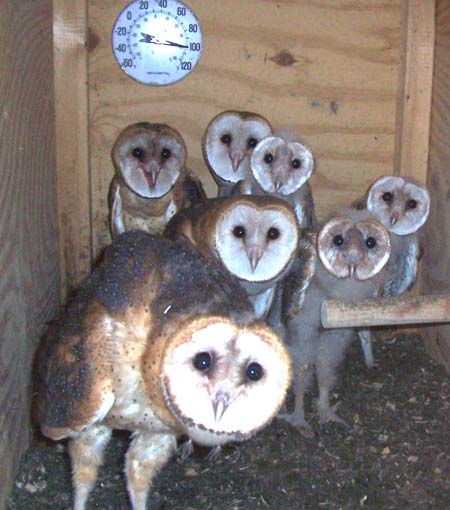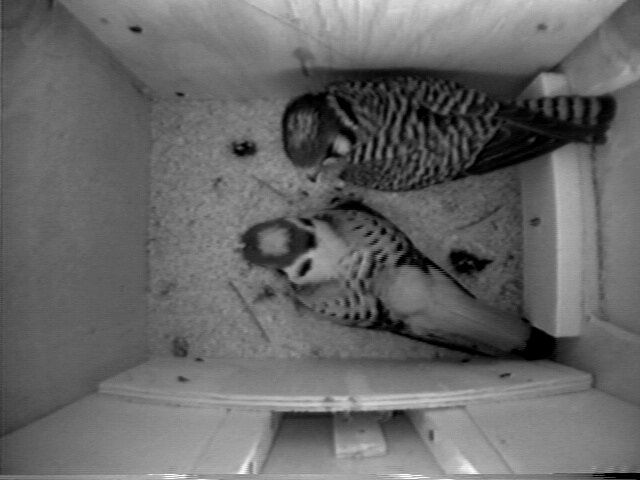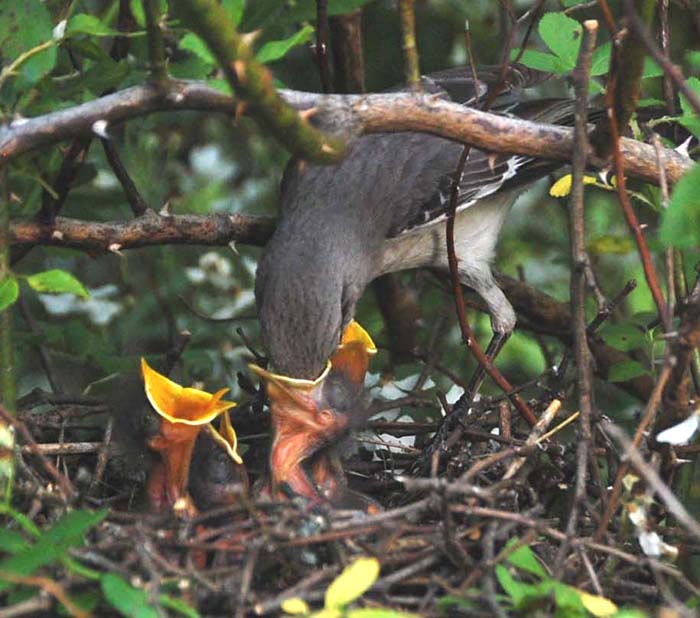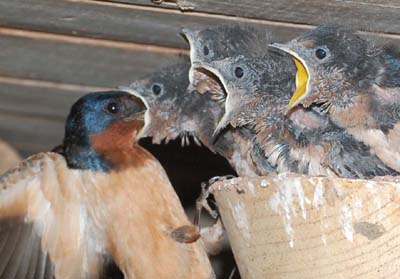Richard and Diane Van Vleck Personal Pages The Home Habitat |


Richard and Diane Van Vleck Personal Pages The Home Habitat |


After experimenting with a webcam and a color video camera, I chose a miniature B&W camera with infrared lighting. The B&W camera requires far less light for a good picture than comparable color cameras. But, more importantly, the B&W ccd is sensitive to infrared light and small infrared emitters provide a bright video picture in total darkness. This means the scene doesn't go dim every time the adult blocks the entrance hole when returning with food. It also means everything that goes on in the nest in the middle of the night can be recorded on videotape. I was surprised at the amount of activity in all the boxes in total darkness.
5/29/2001 Today I retrieved the camera from the kestrel box and mounted it over one of the artificial barn swallow nests. When the eggs hatch I may run some 24 hour video on this nest to study next winter when there is more time for such things. Already I am fascinated at what the camera has shown on just a few minutes of tape. The infrared works beautifully on this nest and also in the bluebird boxes. The light is further away in the kestrel box and in the barn owl nest I taped earlier this spring, causing vignetting around the edges and a rather low contrast in total darkness. But, even on these larger boxes it still works.
I just returned from a midnight swallow check on the tv in the workshop. I find myself doing this every few hours each night. The pair are resting comfortably, but the female is preening more vigorously than usual - probably a few feather mites or lice. The bluebirds and tree swallows are checked more conveniently, since they are both connected to a vcr and tv downstairs in Diane's office. I'm not that fond of vcr's, but I did give in and buy two $69 models at a Target store for this project. Geez they've gotten cheap! The two nestboxes are connected with an A-B antenna switch so I can alternately view and record either box on one vcr.
 2002
2002
This spring we are videotaping only new species since I haven't had time to look at over 600 hours of the 2001 nestbox video. An exception is the kestrel nest in their new tower in front of the house.
The chickadee nesting this year was successful, with no interference from the house wrens who were nesting 12 feet away in a gourd. The chickadees fledged earlier this week and we have many hours of video, including night infrared throughout incubation, brooding and feeding. While our barn swallows had a rough start because of unusually cold windy weather, the chickadees always had an abundant food supply, even in the worst weather due to their different method of foraging. Our two pairs of bluebirds also were bringing great mouthsfull of insects to their nests during the bad weather.
The greatest success this year, although it is far from over, is a successful hatching in the flicker box. I've trapped or shot over 150 starlings this spring and they are still coming to the nestboxes, but it looks like the flickers will be able to finally rear a brood this year.
Other than the frequent starling raids on the flicker box, the most excitement this spring was the appearance of a pair of great crested flycatchers who were also quite interested in the flicker box. They now have 7 new cedar boxes to choose from, but after two days of checking the flicker box and ignoring the new boxes which were all in place the second day, they have vanished from the yard.
8/22/2002 The only current nests this late are our goldfinches. Juvenile towhees, mockingbirds, thrashers, catbirds, and several other species are still frequently feeding in the yard. The flickers successfully nested this year with the benefit of around 200 fewer starlings threatening them. The pair of crested flycatchers showed interest in the boxes in the pines, but were still competing with too many starlings at that time. Next year they should have it made. Another highlight of this summer was the appearance in our yard of a female bluebird with 2 recently fledged young last week. These fledglings were not from any of my boxes. Our two pair had two and three broods in their boxes, but these young were from a natural cavity somewhere on our 17 acres. The adults were likely the pair who previously had two broods in the rear garden box. It would be a sad thing indeed for bluebirds to go the way of the purple martin and become totally dependent on nestboxes provided by humans.
 2003
2003
This year barn owls were videotaped throughout their nesting and house wrens and tree swallows were recorded periodically. A mockingbird nest was also taped for several days and nights. One interesting observation at both the mockingbird and tree swallow nests was the constant presence of mosquitoes at night. The nestlings were continuously being bitten and seemed to get very little rest, continually flinching. The adults caught and ate quite a few mosquitoes until it got dark. Then they seemed helpless to do anything and simply endured the constant biting. Watching the video with infrared illumination, I often forget that the nest box is pitch black to the birds.
2004
This spring, I acquired a cheap quad splitter that enabled me to record 4 cameras on one tape. This allowed me to monitor 4 starling nest box traps on a single tape, and, in some cases, to place the camera inside a prototype trap to see how the starling reacted. I was also able to insert video of a weather cam alongside three barn swallow nest cams to gather data on feeding activity in relation to weather. As the season progressed, I turned the cameras on my bat boxes, again, with the weather cam and three bat cams displayed on one tape. Reviewing the tape in fast forward, the exact time of each bat's emergence was noted. The weather cam is a home made affair incorporating a dial thermometer, part of an anemometer (the spinning cups)and a large funnel to concentrate rainfall which then splashes on a flap, making it more visible to the infrared camera. This crude device can certainly be improved by others, but proved servicable for this year's pilot tests. I didn't run enough tape on enough nights to get really useful data.
New species videotaped this year were a gray squirrel that used a screech owl box in the pines and a starling that used the front yard flicker cavity in an old sycamore. This nesting was, of course, terminated early. Also, a new bluebird box with slanted cam port was tested in the back yard. While intended for bluebirds, as soon as the box was changed in early April, the bluebirds moved to one of the lathe turned boxes 100 ft away. When the tree swallows returned, they readily accepted the slant box and the angled video was great. I had thought that tree swallows would likely obstruct the view with their white chicken feathers. This really throws off the auto exposure. But, surprisingly, they left a clear view throughout the nesting, even though the feathers were present. I had planned to offer the slant box this year, since the improved camera angle was great, but have decided that another year of testing is in order. I may have just been lucky with the tree swallows. And, I would like to see a pair of bluebirds choose the box. They have been frequently entering the slant box this fall.
 July 19, 2005 This year, the open nest of brown thrashers was recorded, as well as purple martins in a super gourd and yellow shafted flickers in both their barnyard box and a second pair in the sycamore cavity. Also, video cameras recorded the activity of the big brown bats at their two large bat boxes. A weather cam provided weather data on the bat recordings so their activity could be correlated with both time and weather. The kestrels once again have a second brood! If I find time, I may take a vcr out to their tower and record this late nesting, also. And, moving on from birds, I also ran videotape of a sand wasp nest in our front yard. The comings and goings of these wasps at their burrows will be interesting video for next winter. Hopefully the prey they are bringing to provision the burrow will be identifiable in the video.
July 19, 2005 This year, the open nest of brown thrashers was recorded, as well as purple martins in a super gourd and yellow shafted flickers in both their barnyard box and a second pair in the sycamore cavity. Also, video cameras recorded the activity of the big brown bats at their two large bat boxes. A weather cam provided weather data on the bat recordings so their activity could be correlated with both time and weather. The kestrels once again have a second brood! If I find time, I may take a vcr out to their tower and record this late nesting, also. And, moving on from birds, I also ran videotape of a sand wasp nest in our front yard. The comings and goings of these wasps at their burrows will be interesting video for next winter. Hopefully the prey they are bringing to provision the burrow will be identifiable in the video.
Nov 5, 2006 The great surprise this year was a polygamous barn owl nesting with the two females sharing not only the same nest box, but the same nest. And, its all on tape! There were no new cavity nesting species in the yard and no other nests were recorded. The kestrels once again had two broods in their tower and both the front and backyard bluebirds each reared two broods.
2006 polygamous barn owl nesting cam
| barn owl | American kestrel | purple martin | barn swallow | Eastern bluebird |
| tufted titmouse | Eastern phoebe | yellow shafted flicker | tree swallow | chimney swift |
| house wren | big brown bat | Carolina wren | brown thrasher | catbird |
| cedar waxwing | Northern mockingbird | |||
| Yellow warbler | Acadian flycatcher | |||
email richard@americanartifacts.com
© 2013, American Artifacts and Richard Van Vleck, Taneytown, Maryland.